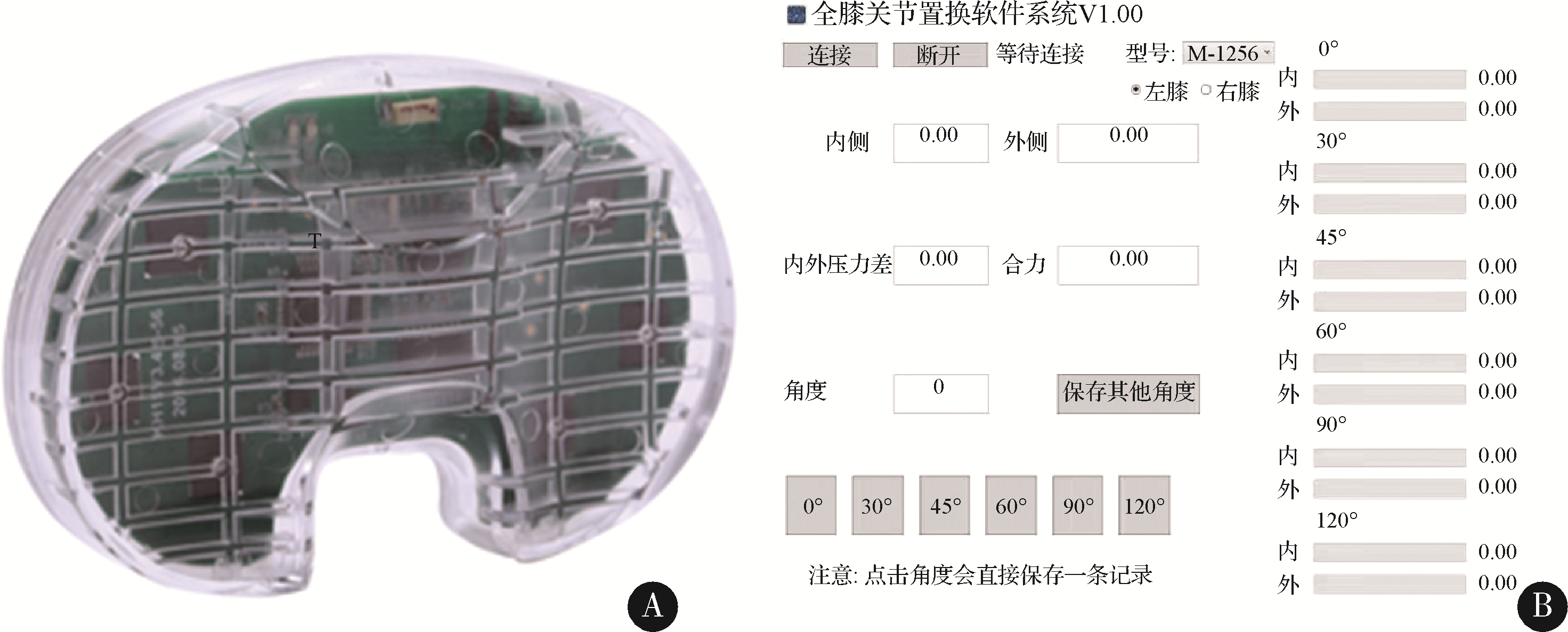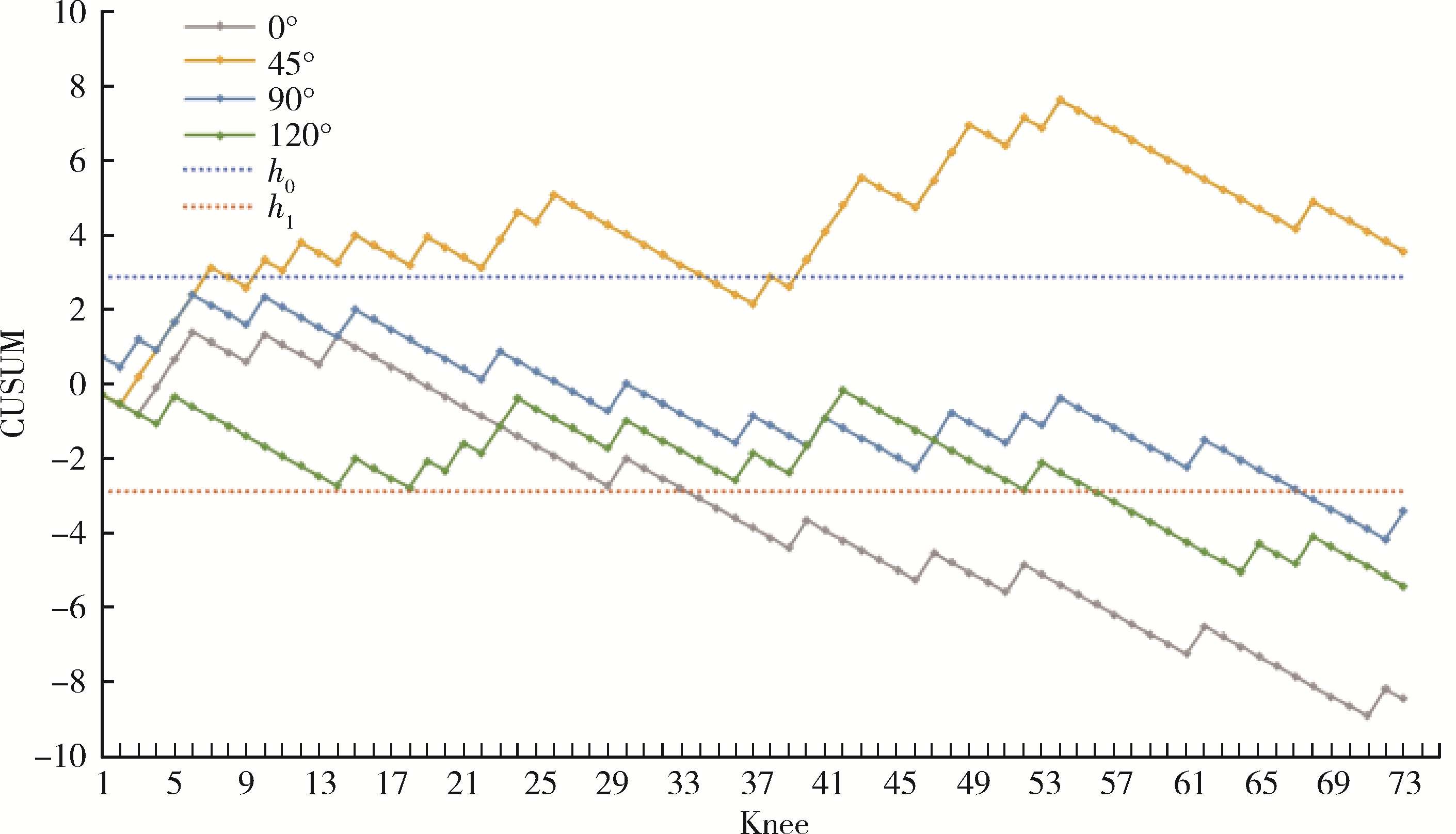Journal of Peking University (Health Sciences) ›› 2023, Vol. 55 ›› Issue (4): 658-664. doi: 10.19723/j.issn.1671-167X.2023.04.015
Previous Articles Next Articles
Cumulative sum control chart analysis of soft tissue balance in total knee replacement assisted by electronic pressure sensor
Ran ZHAO,Yan-qing LIU*( ),Hua TIAN*(
),Hua TIAN*( )
)
- Department of Orthopedics, Peking University Third Hospital, Beijing 100191, China
CLC Number:
- R687.4
| 1 | ElmallahRK,MistryJB,CherianJJ,et al.Can we really "feel" a balanced total knee arthroplasty?[J].J Arthroplasty,2016,31(Suppl 9):102-105. |
| 2 |
GustkeKA,GolladayGJ,RocheMW,et al.Increased satisfaction after total knee replacement using sensor-guided technology[J].Bone Joint J,2014,96-B(10):1333-1338.
doi: 10.1302/0301-620X.96B10.34068 |
| 3 |
BellemansJ,VandenneuckerH,Van LauweJ,et al.A new surgical technique for medial collateral ligament balancing: Multiple needle puncturing[J].J Arthroplasty,2010,25(7):1151-1156.
doi: 10.1016/j.arth.2010.03.007 |
| 4 |
YapCH,ColsonME,WattersDA.Cumulative sum techniques for surgeons: A brief review[J].ANZ J Surg,2007,77(7):583-586.
doi: 10.1111/j.1445-2197.2007.04155.x |
| 5 |
WoonCYL,CarrollKM,LymanS,et al.Dynamic sensor-balanced knee arthroplasty: Can the sensor "train" the surgeon?[J].Arthroplast Today,2019,5(2):202-210.
doi: 10.1016/j.artd.2019.03.001 |
| 6 | CanovasF,DagneauxL.Quality of life after total knee arthroplasty[J].Orthop Traumatol Surg Res,2018,104(Suppl 1):S41-S46. |
| 7 | Van DammeG,DefoortK,DucoulombierY,et al.What should the surgeon aim for when performing computer-assisted total knee arthroplasty?[J].J Bone Joint Surg Am,2005,87(Suppl 2):52-58. |
| 8 |
KhanN,AbboudiH,KhanMS,et al.Measuring the surgical "learning curve": Methods, variables and competency[J].BJU Int,2014,113(3):504-508.
doi: 10.1111/bju.12197 |
| 9 |
RamsayCR,GrantAM,WallaceSA,et al.Assessment of the learning curve in health technologies. A systematic review[[J].Int J Technol Assess Health Care,2000,16(4):1095-1108.
doi: 10.1017/S0266462300103149 |
| 10 |
ZhaoR,LiuY,TianH.Accuracy of soft tissue balancing in total knee arthroplasty using surgeon-defined assessment versus a gap-balancer or electronic sensor[J].J Orthop Surg Res,2021,16(1):305.
doi: 10.1186/s13018-021-02439-w |
| 11 | 孙晓威,张启栋,任鹏鹏,等.全膝关节置换关节间隙压力传感器的研究现状[J].中国矫形外科杂志,2020,28(19):1774-1778. |
| 12 |
GustkeKA,GolladayGJ,RocheMW,et al.A new method for defining balance: Promising short-term clinical outcomes of sensor-guided TKA[J].J Arthroplasty,2014,29(5):955-960.
doi: 10.1016/j.arth.2013.10.020 |
| 13 |
MacDessiSJ,GharaibehMA,HarrisIA.How accurately can soft tissue balance be determined in total knee arthroplasty?[J].J Arthroplasty,2019,34(2):290-294. e1.
doi: 10.1016/j.arth.2018.10.003 |
| 14 |
LakraA,SarpongNO,JenningsEL,et al.The learning curve by operative time for soft tissue balancing in total knee arthroplasty using electronic sensor technology[J].J Arthroplasty,2019,34(3):483-487.
doi: 10.1016/j.arth.2018.11.014 |
| 15 |
MeneghiniRM,Ziemba-DavisMM,LovroLR,et al.Can intra-operative sensors determine the "target" ligament balance? Early outcomes in total knee arthroplasty[J].J Arthroplasty,2016,31(10):2181-2187.
doi: 10.1016/j.arth.2016.03.046 |
| 16 |
VerstraeteMA,MeerePA,SalvadoreG,et al.Contact forces in the tibiofemoral joint from soft tissue tensions: Implications to soft tissue balancing in total knee arthroplasty[J].J Biomech,2017,58,195-202.
doi: 10.1016/j.jbiomech.2017.05.008 |
| 17 |
RocheM,ElsonL,AndersonC.Dynamic soft tissue balancing in total knee arthroplasty[J].Orthop Clin North Am,2014,45(2):157-165.
doi: 10.1016/j.ocl.2013.11.001 |
| 18 |
LeDH,GoodmanSB,MaloneyWJ,et al.Current modes of fai-lure in TKA: Infection, instabi-lity, and stiffness predominate[J].Clin Orthop Relat Res,2014,472(7):2197-2200.
doi: 10.1007/s11999-014-3540-y |
| 19 |
StamboughJB,EdwardsPK,MannenEM,et al.Flexion instabi-lity after total knee arthroplasty[J].J Am Acad Orthop Surg,2019,27(17):642-651.
doi: 10.5435/JAAOS-D-18-00347 |
| 20 |
HinoK,KutsunaT,OonishiY,et al.Assessment of the midfle-xion rotational laxity in posterior-stabilized total knee arthroplasty[J].Knee Surg Sports Traumatol Arthrosc,2017,25(11):3495-3500.
doi: 10.1007/s00167-016-4175-1 |
| 21 | ParratteS,PagnanoMW.Instability after total knee arthroplasty[J].J Bone Joint Surg Am,2008,90(1):184-194. |
| 22 |
VajapeySP,PettitRJ,LiM,et al.Risk factors for mid-flexion instability after total knee arthroplasty: A systematic review[J].J Arthroplasty,2020,35(10):3046-3054.
doi: 10.1016/j.arth.2020.05.026 |
| 23 |
ClaryCW,FitzpatrickCK,MaletskyLP,et al.The influence of total knee arthroplasty geometry on mid-flexion stability: An expe-rimental and finite element study[J].J Biomech,2013,46(7):1351-1357.
doi: 10.1016/j.jbiomech.2013.01.025 |
| 24 |
HinoK,IshimaruM,IsekiY,et al.Mid-flexion laxity is greater after posterior-stabilised total knee replacement than with cruciate-retaining procedures: A computer navigation study[J].Bone Joint J,2013,95-B(4):493-497.
doi: 10.1302/0301-620X.95B4.30664 |
| 25 | EvangelistaPJ,LasterSK,LenzNM,et al.A computer model of mid-flexion instability in a balanced total knee arthroplasty[J].J Arthroplasty,2018,33(Suppl 7):S265-S269. |
| 26 |
LuyckxT,VandenneuckerH,IngLS,et al.Raising the joint line in TKA is associated with mid-flexion laxity: A study in cadaver knees[J].Clin Orthop Relat Res,2018,476(3):601-611.
doi: 10.1007/s11999.0000000000000067 |
| 27 |
MatziolisG,BrodtS,WindischC,et al.The reversed gap technique produces anatomical alignment with less midflexion instability in total knee arthroplasty: A prospective randomized trial[J].Knee Surg Sports Traumatol Arthrosc,2016,24(8):2430-2435.
doi: 10.1007/s00167-015-3798-y |
| 28 |
MochizukiT,TanifujiO,SatoT,et al.Association between anteroposterior laxity in mid-range flexion and subjective healing of instability after total knee arthroplasty[J].Knee Surg Sports Traumatol Arthrosc,2017,25(11):3543-3548.
doi: 10.1007/s00167-016-4375-8 |
| 29 |
BabisGC,TrousdaleRT,MorreyBF.The effectiveness of isolated tibial insert exchange in revision total knee arthroplasty[J].J Bone Joint Surg Am,2002,84(1):64-68.
doi: 10.2106/00004623-200201000-00010 |
| 30 |
AbdelMP,PulidoL,SeversonEP,et al.Stepwise surgical correction of instability in flexion after total knee replacement[J].Bone Joint J,2014,96-B(12):1644-1648.
doi: 10.1302/0301-620X.96B12.34821 |
| 31 |
SchwabJH,HaidukewychGJ,HanssenAD,et al.Flexion instability without dislocation after posterior stabilized total knees[J].Clin Orthop Relat Res,2005,440,96-100.
doi: 10.1097/00003086-200511000-00018 |
| 32 |
LongoUG,CiuffredaM,ManneringN,et al.Outcomes of posterior-stabilized compared with cruciate-retaining total knee arthroplasty[J].J Knee Surg,2018,31(4):321-340.
doi: 10.1055/s-0037-1603902 |
| 33 |
van der LindeJA,BeathKJ,LeongAKL.The reliability of sensor-assisted soft tissue measurements in primary total knee arthroplasty[J].J Arthroplasty,2018,33(8):2502-2505. e12.
doi: 10.1016/j.arth.2018.03.067 |
| [1] | Si-yu WU,Ya-ning LI,Xiao ZHANG,Long-wei LV,Yun-song LIU,Hong-qiang YE,Yong-sheng ZHOU. Prediction, analysis and application of learning curve of tooth preparation for all ceramic crowns of maxillary central incisors [J]. Journal of Peking University (Health Sciences), 2023, 55(1): 108-113. |
|
||





